   |
Manhua-ka: Song Yang
Publisher: Yen Press
Rating: Older Teen (16+)
Released: September 2008
Synopsis: “Coming of age during the Cultural Revolution in China, sixteen-year-old Ma Xiaojun yearns to rebel against the system. But while he manages to get into plenty of trouble with his friends, he also nurtures a more solitary side and a mysterious obsession with keys. When maturity yields a newfound interest in the opposite sex, Xiaojun finds himself intrigued by the untouchable Mi Lan. Will he ever find the key to unlock the enigmas she presents?”
Wild Animals is the story of Ma Xiaojun, a Chinese teen living during the Cultural Revolution. He runs with a questionable crowd, skips school and generally does what he wishes in a society he enjoys rebelling against. It’s 240 pages of life in China-past through the eyes of its youth.
When I first began reading Wild Animals, I had no idea what was going on. I couldn’t pinpoint who the story was following, what kind of pacing the writer was trying to pull of and the art was wildly inconsistent (though intentionally so). Fortunately when chapter two rolled around, the story took a more linear, focused track and I was able to start enjoying the book.
 Ma Xiaojin feels like a well-portrayed teenager: reckless, cheeky and laid-back about nearly everything in his life. It was nice seeing his interactions with so many different people and how they showed the varied layers of his teenage personality, from his too-cool-for-you buddies, to an older girl he’s become fascinated with, and on the flipside the occasional run-in with police and his parents. I kept being surprised by some of his actions, those both light and dark, but more than seeming out of place, they served to make him as unpredictable as a person truly should be, especially for someone just learning who he is.
Ma Xiaojin feels like a well-portrayed teenager: reckless, cheeky and laid-back about nearly everything in his life. It was nice seeing his interactions with so many different people and how they showed the varied layers of his teenage personality, from his too-cool-for-you buddies, to an older girl he’s become fascinated with, and on the flipside the occasional run-in with police and his parents. I kept being surprised by some of his actions, those both light and dark, but more than seeming out of place, they served to make him as unpredictable as a person truly should be, especially for someone just learning who he is.
Yen Press’s job on the book is really nice, from the attractive design of the cover and spine, to the well-chosen cut size (which is a little larger than standard English-released mangas). The interior rewrites were done well and they enhanced Ma Xiaojin with appropriate style of speech. One quip I did have was the story’s synopsis, which plays up the lead’s obsession with keys as a pulling point of the plot, when instead it played a very minor role.
 The most notable attribute of the story is undoubtedly Song Yang’s artwork. Many parts of the book look like scattered pictures the artist has done and wanted to find a place more, giving spots a very out of place appearance. Some images looked painted, some cartoony and other like over-the-top characterizations. It’s a little disorienting at first but you get used to it. I liked the key style used in the book, which the majority of the story is told through. The characters were expressive and distinctive, especially Ma Xiaojun, and once you reach the end of the volume, the whole thing feels a lot more polished art-wise.
The most notable attribute of the story is undoubtedly Song Yang’s artwork. Many parts of the book look like scattered pictures the artist has done and wanted to find a place more, giving spots a very out of place appearance. Some images looked painted, some cartoony and other like over-the-top characterizations. It’s a little disorienting at first but you get used to it. I liked the key style used in the book, which the majority of the story is told through. The characters were expressive and distinctive, especially Ma Xiaojun, and once you reach the end of the volume, the whole thing feels a lot more polished art-wise.
As a whole, I found Wild Animals to be a pretty good read once I made my way over the initial bumps and got accustomed to the unique styling of the book. What makes me wonder though is who this book would best be targeted to. It certainly falls in a vein more indy than mainstream so I suppose I’d recommend it to those looking for something that’s distinctly different than most other books of its kind available in English today. A unique take on the art and a interesting, calmly-paced story told from the eyes of an animated youth, made Wild Animals an interesting read though one that will probably have trouble finding a market.
Review written November 5, 2008 by Lissa Pattillo.
Book provided by Yen Press for review purposes


 Follow
Follow

























[…] Kiara hits the books with Haridama Magic Cram School at Manga Jouhou. Lissa Pattillo reads vol. 1 of Wild Animals, Only Words, and You Make My Head Spin!, and guest reviewer Marsha Reid reviews vol. 1 of Suzunari. […]